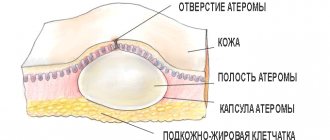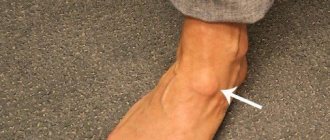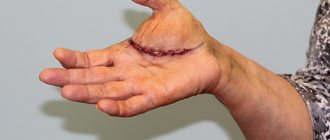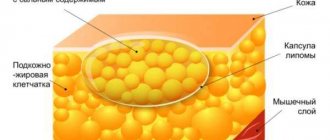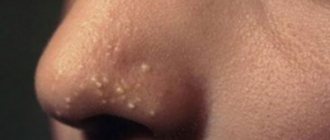A lipoma, or, as people say, a wen, is most often just a cosmetic defect that does not threaten human health. But if the wen bursts or becomes inflamed, this is a good reason to worry. After all, if an ordinary wen brings mostly psychological discomfort, then an inflamed and burst one can cause the addition of new dangerous infections.
Rupture of a wen is not a dangerous phenomenon, but the fact of its occurrence should not be ignored.
What it is
Although such neoplasms can be found in almost every person, not everyone knows what a lipoma is and how it is dangerous. This formation is benign and is a tumor of adipose tissue. Sometimes lipoma is confused with acne or lymph nodes. If there are a lot of small wen on the body, then they talk about lipomatosis.
Wen can be localized on the scalp or on any other part of the body where adipose tissue is present. They are usually small in size, but can become larger over time. Very small wen, the size of a match head, may appear under the eyes or on the eyelids. When especially large wen are probed, lobulation in their structure is sometimes revealed.
Rehabilitation
After suturing, the patient is given a little time to recover, after which he goes home. Since the removal is minimally invasive, there is no need for hospital treatment.
Throughout the wound healing period, heavy physical exertion should be avoided, as this can cause the sutures to come apart. Superficial tissue fusion ends in 1.5–2 weeks.
Complete healing occurs only after 2–3 months. As a rule, in the first 10 days, the patient is given sick leave. After this time, he can already begin to perform his professional duties.
Causes
Scientists still cannot explain with absolute certainty why wen appears on the body. The psychosomatics of lipomas also continue to be studied. But the main provoking factor contributing to the formation of wen is considered to be an unhealthy diet, rich in trans fats, preservatives and fast carbohydrates.
In addition, experts identify a number of conditions that can trigger the formation of wen. These include:
- violation of fat metabolism;
- hormonal fluctuations;
- congenital anomalies that appeared during intrauterine development;
- endocrine pathologies;
- the presence of diseases of the liver, pancreas, gall bladder;
- nephrological pathologies;
- vitamin deficiency (lack of vitamins and microelements);
- smoking, alcohol abuse;
- increased blood cholesterol levels;
- insufficient physical activity (physical inactivity);
- decreased immune status;
- frequent stay of the body in a stressful state;
- experienced plastic surgery.
Also, the culprits for the appearance of wen may not be internal factors, but the usual blockage of the outlet of the sebaceous glands. If lipomas form on the head, this may be due to hypothermia (the habit of walking without a hat in cold weather).
Further actions
This neoplasm can break through, but it (in most cases) cannot completely clear itself. Therefore, it is so important that the patient immediately goes to the doctor.
Wen is not a dermatological disease, and the patient should seek help from an oncologist. He will examine the area affected by the disease, assess the severity of the process and, based on this, prescribe the most correct treatment. It consists of complete removal of the tumor. It can be performed by cosmetologists, dermatologists or surgeons. The choice of a specialist in this case depends on the size of the lipoma, as well as the area in which it is located.
Symptoms
The following signs will help differentiate wen from other neoplasms:
- their shape is smooth, rounded with clear boundaries;
- upon palpation they are soft and elastic;
- move freely over the skin;
- do not cause pain at the site of the tumor;
- there are no signs of an inflammatory process.
The size of the wen can vary from 1 mm to 7 cm. The color of the skin over the neoplasm does not change, but due to the accumulation of adipose tissue, it sometimes acquires a yellowish tint. Wen can appear anywhere there is adipose tissue. But they never appear on the feet and palms.
Lipoma of internal organs, unlike the subcutaneous form, is not visually diagnosed, and at the site of its localization the patient experiences pain. If the wen increases in size over time, they can put pressure on adjacent organs. And also a distinctive feature of lipomas is that when the patient’s weight decreases, they, on the contrary, increase.
Can it burst on its own?
Wen is not dangerous to life and health.
The tumor never becomes malignant; it is enclosed in a capsule. But under certain circumstances, inflammation and even a breakthrough to the surface of the skin is possible. Provoking factors of inflammation:
- regular mechanical impact with a comb, hairpins, jewelry;
- injury from a fall or fight;
- rubbing with tight underwear, shoes;
- attempts to squeeze out or cut off a lipoma at home, it may burst.
Suppuration causes aching pain, aggravated by palpation, hyperemia, and increased formation. Soon spontaneous opening occurs, which is dangerous due to secondary infection. If the wen bursts under the skin, you need to contact a surgeon to develop treatment tactics.
Why are they dangerous?
Having discovered such a tumor on their body, patients are interested in whether the wen is dangerous. As a rule, all these neoplasms are benign in nature, but the risk of their degeneration into liposarcoma cannot be excluded. Such a danger should alert patients and they should not hesitate to visit a doctor in order to be sure that the tumor is benign and not to waste time if it becomes malignant.
The development of a pathological process can be suspected based on the following signs:
- dynamic increase in tumor size;
- when you press on the wen, pain appears;
- the color and shape of the tumor changes, and an inflammatory process develops in adjacent tissues;
- Serous fluid begins to be released from the wen.
If a patient develops such symptoms, this may be an alarming signal that the process of malignancy has begun in the wen. Usually such tumors are removed urgently. After the resection is completed, fragments of the removed tissue are necessarily sent for histological examination to confirm the nature of the tumor.
Most often, lipomas do not bother a person in any way, but there is still a risk of accidental damage or rubbing with clothing. If the wen breaks through, the burst surface can become an entry point for a secondary infection. In addition, unsightly formations on open areas of the body become a serious cosmetic problem.
Signs and dangers
This pathology is quite easy to distinguish from other diseases. The wen is soft to the touch, you can easily roll it with your fingers and this does not cause pain. Sometimes such a tumor can affect the connective tissues - in this case, it will have a denser structure. The density of this neoplasm depends on what part of the body and how deep it is located. The deeper the wen is, the denser the consistency it will have.
How dangerous is this pathology? As has already been clarified, a wen is a benign tumor that consists of adipose tissue. There are several varieties of this pathology, some of which can develop into a malignant tumor - liposarcoma.
The greatest danger to human life is posed by a type of wen called myelolipoma. If this disease develops, the fatty tissues inside the tumor begin to combine with blood vessels, which often leads to malfunctions of many internal organs. That is why, when the first signs of the disease appear, it is necessary to visit a doctor.
Diagnostics
A doctor can diagnose a lump under the skin based on a physical examination. If the tumor is too large and located deep, then a number of additional examinations may be needed. In addition, tumors that have a questionable shape (tumor without a capsule) are subjected to careful diagnosis.
To exclude liposarcoma, a biopsy is required. To do this, a biopsy of tumor tissue is taken and sent for histological and cytological examination. If the patient is suspected of having a lipoma of deep tissues or internal organs, then instrumental studies are performed: ultrasound, CT, MRI.
Preparatory activities
A few days before the procedure, the doctor prescribes a comprehensive examination for the patient, which must include:
- general blood and urine tests;
- blood test for syphilis, hepatitis and HIV;
- cardiac examination;
- Ultrasound of the affected area
- X-ray examination, which is prescribed in the case of a voluminous wen located close to the bone tissue.
If the patient has chronic pathologies, then consultation with his attending physician is necessary. At the preparation stage, the anesthesiologist finds out whether the patient is allergic to anesthetics. Based on the data obtained, the necessary painkiller is selected.
This article describes what melanoma looks like in its early stages.
After diagnosis, the patient is introduced to the rules of preparation for surgery:
- when administering general anesthesia, it is necessary to refrain from eating at least 8 hours before removal. If it is planned to perform the operation under local anesthesia, then the last meal should be no less than 2 hours before excision of the wen;
- it is advisable not to smoke several hours before the procedure, as nicotine in the blood increases the risk of complications;
- You should not drink alcohol on the day of surgery or a few days before. This may cause unpredictable effects of anesthesia;
- For surgery, the patient is recommended to come with an assistant who will help him get home. It is not recommended to drive, as concentration and attention may deteriorate after anesthesia.
Treatment options
Having discovered a tumor, patients first of all want to know which doctor to go to with a lump. The size of the tumor will help you decide which specialist to contact. Lipomas from 0.5 mm to 1 cm are dealt with by cosmetologists and dermatologists. If the wen is large and located on the head, face or in the genital area, then you should contact a specialized surgeon.
Medication
If the tumor is small in size (up to 2-3 cm), but inflammation of the wen is observed, then the patient may be recommended to administer Diprospan directly to the pathological focus.
This drug stimulates the rapid breakdown of adipose tissue.
The dose of Diprospan is calculated depending on the clinical picture and severity of the disease. However, it should be borne in mind that this medicine has a large number of side effects and contraindications, so it can only be used under the supervision of a doctor. For the lipoma to completely resolve, 2-3 injections may be needed.
Surgical
Radical removal of wen can be carried out using the following methods:
- Surgical excision. A wide incision is made on the skin and the lipoma is removed along with the capsule. Resection is performed under local anesthesia. This method allows you to completely remove the formation and eliminate re-growth. However, after such an operation, noticeable scars remain.
- Endoscopic removal. Compared to classic removal, during endoscopic intervention it is necessary to make an incision of up to 1 cm. The entire process is carried out using a mini endoscope. From a cosmetic point of view, this method is much better, but it does not exclude the possibility of relapse (recurrence of lipoma may occur in the near future).
- Liposuction. The fatty tissue from the lipoma is suctioned out using a lipoaspirator tube through an incision of about 5 mm. When using this method, the best cosmetic effect is achieved after removing the lipoma, but due to the lack of control over the completeness of lipoma removal, there is a high probability of relapse.
In addition, modern dermatology and surgery practice laser and radio wave removal of lipomas. These methods are considered gentle and safest for the patient.
Why does a wen appear on the head and how to get rid of it?
Wen on the head is not a rare phenomenon that can occur in people of different ages and both sexes.
Such a formation can significantly spoil a person’s appearance and, although it causes virtually no discomfort, the wen creates some inconvenience when combing and washing hair .
General information
Wen can appear on any part of the human body, but most often it appears on the head, this is due to the fact that a large number of sebaceous glands are concentrated in the scalp.
At its core, a lipoma (fat) is a benign formation, which is a piece of adipose tissue. It develops as a result of obstruction of the sebaceous glands, and most often occurs in people with problems with the kidneys, liver, digestion, or metabolic disorders in the body.
Important! If the formation is removed in a timely manner, it is not at all dangerous to health.
In some cases, lipoma is confused with atheroma, another disease that is very similar to a wen both in appearance and in composition. But a wen forms under the skin, while atheroma is located in the skin itself, this explains its immobility and is different from a moving wen.
Reasons for appearance
The reasons why an unattractive bump may appear on your head are different.
In some cases, the pathology develops due to improper functioning of the sebaceous glands, in others it is a consequence of improper lipid metabolism, and thirdly, the impetus for the development of a wen is a genetic predisposition.
There are a number of other provoking factors that can also trigger the appearance of a wen:
- diseases of the endocrine system;
- hormonal imbalances;
- pathologies of the gastrointestinal tract;
- predominance of fatty foods in the diet;
- frequent stress;
- bad habits;
- increased sweating;
- weak immune system;
- inactive lifestyle;
- lack of proper hygiene;
- harmful production conditions;
- intoxication processes.
Despite such a variety of provoking factors, their presence does not necessarily lead to the formation of a wen.
Photo
You can visually see the wen on the head in the photo below:
How to get rid of it?
Wen can be treated only after consultation with a doctor . During the examination, the specialist will analyze the contents of the lipoma for cytology and histology. In the course of these studies the nature of education will be determined.
If malignant cells are detected in the lipoma tissue, the patient is referred to an oncologist for further treatment. Under this condition, touching the tumor, much less carrying out any manipulations on it, is very dangerous.
If the tumor is benign, then the lipoma can be removed surgically or by injecting a special drug that can resolve fatty deposits. Several such procedures are required until the wen completely disappears; in some cases, such treatment is delayed for several months.
If the tumor cannot be removed using a minimally invasive method, the doctor may suggest surgical treatment. This intervention is performed under general anesthesia. The doctor makes an incision in the skin, pumps out the contents of the wen and removes its capsule. After surgery, a scar remains on the skin.
There are alternative ways to remove lipoma:
- Laser therapy . A laser beam is directed onto the surface of the wen, which leads to the destruction of the seal. This is a painless procedure that leaves no scars or scars.
- Endoscopy . In this case, fat deposits are pumped out using a special device. This procedure is not performed in cases where the lipoma compresses blood vessels or nerves.
- Liposuction is another way to get rid of fatty tissue, which also does not leave behind any charms. The disadvantage of the procedure is frequent relapses.
Important! Alternative methods are relatively safe and are suitable for different categories of patients, however, they should only be prescribed by a doctor after diagnostic measures.
Treatment with folk remedies
It is not possible to remove a wen using folk remedies in all cases.
When trying to get rid of a tumor on your own, you must clearly understand that any injury, damage or compression of the wen can cause the degeneration of a benign tumor into a malignant one.
There are many folk recipes for getting rid of lipomas, here are some of them:
- Honey with flour . Prepare the mixture and apply a thick layer to the wen. Place a clean towel or bandage on top. This compress must be kept for a day, and then the procedure must be repeated. A total of 5-7 procedures may be required, after which the wen will disappear.
- Neem oil and flaxseed oil . Neem is a remedy that effectively eliminates various skin fat deposits. Since flaxseed oil contains Omega fatty acids, using it to treat wen can achieve significant results.
- Apple vinegar . It is necessary to apply a tampon soaked in this product several times a day. Carefully! If used incorrectly, this product can cause burns. Vinegar must be diluted with water and not used more than 3 times a day.
It must be said that all possible lotions and compresses can only soften the skin, while the wen capsule remains intact, which after some time leads to a relapse of the disease.
Squeezing out the wen on your own is not only extremely dangerous, but also useless - the connective tissue capsule will not allow you to remove the wen in this way.
And when a lipoma is traumatized, it is possible to either cause an infection and provoke inflammation, or give impetus to the development of an oncological process.
Should it be deleted?
There are indications for removing wen:
- unaesthetic appearance, which leads to a decrease in patient confidence;
- large sizes, resulting in pressure on surrounding tissues and deterioration in their nutrition;
- old wen may die due to impaired blood supply. The wen can rot, which leads to infection of the formation;
- rapid growth of education.
If the wen is small in size, does not tend to grow, does not cause discomfort and does not become inflamed, it does not need to be removed.
Is it dangerous?
To find out whether a wen is dangerous, you need to visit a doctor . Only a specialist can accurately determine the nature of the lipoma and decide whether such a formation needs to be treated.
A benign wen can be dangerous due to infection. Considering that this article discusses wen located on the scalp, a lipoma can be easily injured with a comb.
In addition, there is a risk of transformation of a lipoma into liposarcoma, but this possibility can only be determined by a qualified specialist based on the tests performed.
What to do if the wen bursts?
The wen may burst in the following cases:
- wearing a headdress that constantly puts pressure on education;
- lipoma injury.
A burst wen is a dangerous phenomenon, and in order to avoid serious consequences, it is necessary to take a number of measures:
- it is necessary to remove the liquid that is released from the lipoma with a sterile napkin;
- treat the wound with a disinfectant;
- apply a sterile swab with Levomekol to the wound;
- consult a doctor who will prescribe the necessary treatment.
Features of lipomas
Before you take any action, you need to figure out what kind of wen the situation is. The concept of “wen” applies to almost all benign formations that form under the skin. But most often, two types of tumors are called by this name - lipoma and atheroma.
The first is a non-oncological formation, which is characterized by the accumulation of fat cells in any part of the body. Over time, these cells grow, which leads to an increase in growth. Such a tumor is usually soft and mobile. It has clear boundaries with a delineated outline. Lipoma is not painful. However, if the formation is located in the peritoneum, it can compress neighboring organs, nerve endings and blood vessels. Sometimes the growth grows into organs or completely displaces them from their usual location.
Despite the fact that lipomas are real lipomas, their breakthrough without mechanical damage is impossible. This is due to the absence of a duct. Through it, the tumor would connect with the external environment, and through it, the fat mass would come out.
Consequences of opening under the skin
A ruptured neoplasm, the contents of which fall not outside, but under the skin, poses a huge danger to human health.
The purulent mass, which is in close contact with the tissues of the body, provokes a number of dangerous phenomena:
- increased body temperature;
- inflammation of adjacent tissues;
- the occurrence of bleeding ulcers;
- tissue necrosis;
- amputation.
Atheroma that has opened is dangerous not only to health. It poses a real threat to the patient's life. The longer the purulent accumulation remains under the skin, the more irreversible the consequences become. In such a situation, a person needs urgent medical attention. It is necessary to open, clean and treat with a special antiseptic as soon as possible. But holding such an event on your own is strictly prohibited. The procedure is carried out exclusively in a hospital setting, under the full supervision of an experienced doctor.
If a lipoma opens, there is a high probability of rapid spread of fat cells throughout the human body. In addition to general unpleasant symptoms, there is a risk of lipomatosis. This is a phenomenon in which fat cells spread over a large area and begin to replace healthy cells. Thus, the structure of organs and the whole organism changes. The affected areas stop functioning normally. Tissue degeneration occurs.
Regardless of the type of formation, its damage is dangerous for humans. To avoid complications, the patient should notify the doctor about the current situation as soon as possible. He will take the necessary measures and advise what to do next.
Prevention after a burst wen
After the lipomas have opened and burst on their own, it would be useful to contact a medical facility. A surgeon (ideally an oncologist) will examine the formation and, if necessary, take the discharge for analysis.
The patient’s well-being after the operation is not affected, he immediately goes home. Complications in the form of suppuration and edema are practically not observed. Scars are rare. Complete healing occurs in approximately 5 days. When removing large opened and burst lipomas in difficult anatomical areas (neck, armpits), hospitalization is required. After the operation, antibiotics are prescribed, dressings are performed, and histology of the material is performed.
Methods for removing burst lipomas:
- laser;
- diathermoelectrocoagulation;
- radio wave;
- surgical excision;
- puncture-aspiration method.
Is it possible to heat it?
Dermatologists and cosmetologists strongly do not recommend heating lipomas, especially if there is a suspicion of inflammation of such tumors. Heat can indeed eliminate pain, however, it also activates the inflammatory process and promotes the accumulation of purulent mass. Warming up can be one of the reasons for the spontaneous rupture of a lipoma.
In the absence of inflammation, heat probably won't cause any harm, but it won't do any good either. For those who want to get rid of lipoma, it is better not to self-medicate, but to seek medical help from specialists.
Source of the article: https://moninomama.ru/chistaya-kozha/chto-delat-esli-lopnul-zhirovik-taktika-lecheniya-i-posledstviya-vskryvshejsya-lipomy
In what cases should you consult a doctor?
In most cases, wen represents a purely cosmetic defect. They need to be removed only if the patient experiences psychological discomfort or complains of pain due to pressure on the nerve endings. Ring-shaped lipoma of the neck has this property. If the volume is large, it interferes with breathing and swallowing, can cause suffocation attacks, and can burst. If the growth appears in places where clothing is compressed, the tumor can cause pain and macerate.
Absolute indications for fatty tumor removal:
- localization inside the skull;
- risk of rupture into the abdominal cavity or retroperitoneal region;
- a tumor that disrupts the flow of cerebrospinal fluid;
- a growth inside the heart that causes arrhythmia.
The prognosis for formations is always good. But even after successful removal, they usually appear again on another piece of skin or in the same area, if even a little tumor tissue remains in it. During instrumental removal, the main thing to pay attention to is the professionalism and experience of the doctor.
A mature formation can open or burst on its own. This does not indicate a malignant process. If a wen has broken through, there is no need to squeeze out the unpleasant root, it simply isn’t there.
Source of the article: https://vashaderma.ru/zhiroviki/lopnul






